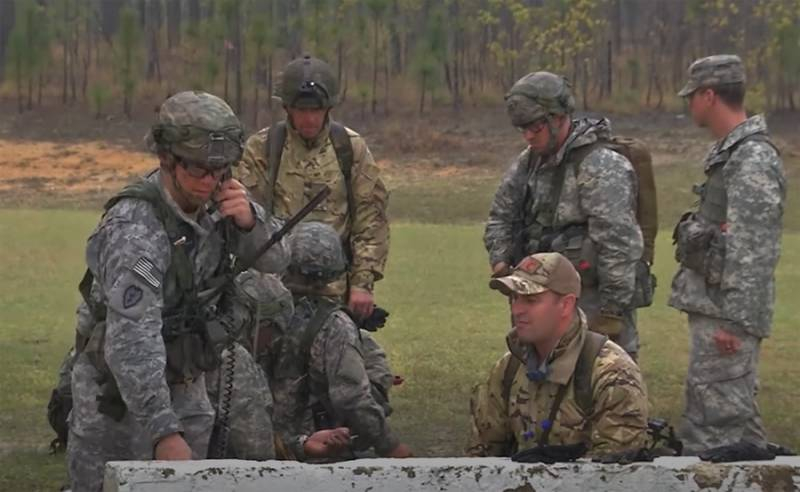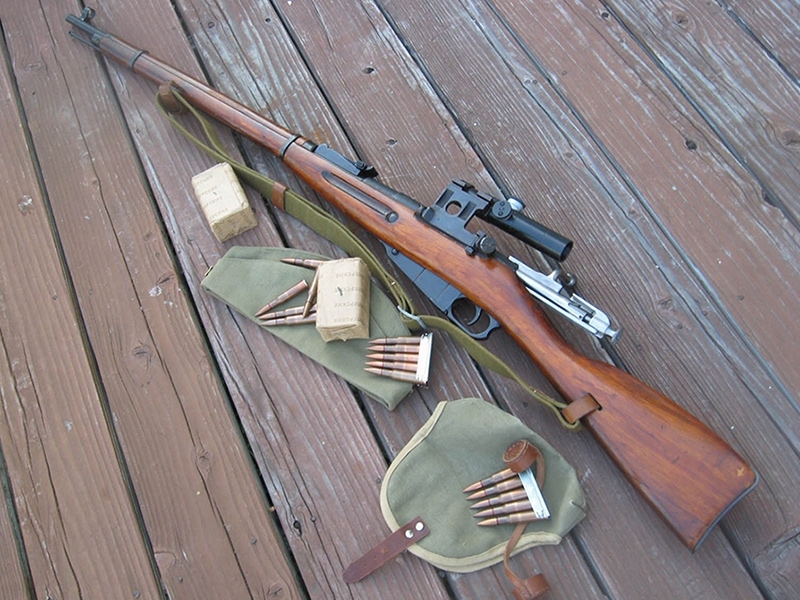
Russian 3-linear (7,62-mm) sample rifle 1891 year - repeating rifle, adopting Russian Imperial Army 1891 year.
Mosin rifle – video
I had other names - 7.62 mm Mosin rifle mod system. 1891 g. (1891/30 gg.) (with the official name 1924 of the year), trohlineyka, Mosin rifle, "Mosinka" and the like. Massively used in the period from 1892 to (in the PLA and the KPA) the end of the 1950s., During this period several times modernized
The name comes from the trohlineyka caliber rifle barrel, which is equal to three lines (old measure of length, equal to one tenth of an inch or 2,54 mm).
On the basis of the sample rifle 1891 year and its modifications has been created a number of sporting and hunting weapons samples, how nareznogo, and smoothbore.

Rifle sample Mosina 1891/1930 gg., right view

Rifle sample Mosina 1891/1930 gg., left view
Magazine rifles with manual reset (in terms of the military affairs of those years - "refresher") have been known since the middle of the XIX century, and even then only a limited military applications.
for example, in the United States during the civil war and hostilities against the Indians use the shopping Spencer rifle with an application store, Henry rifle with magazine and reload the mobile trigger guard, Other systems.
During the Russian-Turkish war of 1877-1878 Turks unsuccessfully used the available in limited quantities (the order of tens of thousands of pieces) magazine rifles Winchester nonmilitary sample models 1866 and 1873 years, developed on the basis of Henry's system - although mass and efficiency of their application, usually, greatly exaggerated.
Many of these systems are well known in Russia, and approximately 1878 We have been actively carried out the purchase of various foreign stores of weapons of samples for research and testing. In the words of General M. AND. Dragomirov in the mid-1870s, "If you invent a repeater system, to be reliable, durable, It will not require too careful care ... at all about what the best dream you can not "

Rifle-line-sample 1891 of the year
However, such a system at that time did not exist. The available samples, though presenting, in theory, significantly higher level of development of small arms compared to widespread as a weapon of war while singly rifles, We had a very significant common shortcomings, due to which they could not be taken on the massive arms of the regular army.
First - in the early store systems because of the design features of their stores (application, grenade) is usually used relatively short and weak cartridges, often rimfire, power close to the turret. for example, in underbarrel tubular store the application centerfire ammunition, to which the type was already owned the majority of military-style ammunition, afraid of casual breaks from hitting the back of the cartridge of the bullet capsule front, so many rifles with the magazine used a rimfire cartridges, instead had a centrally located primer ring primer composition directly into the rim of the sleeve, unsuitable for military weapons.
As a result of the firing range of them left much to be desired, especially taking into account required in the years to this quality of military weapons is clearly excessive demands (which was caused by the presence of practice shooting rifle volleys of group, often even invisible, goals, disappeared after administration of guns), but the bullet did not have the penetrating power, required to hit a target, located behind the ramparts, parapets and other barriers or fortifications.

Rifle-line-sample 1891 year with an eye Konovalova system
Application stores also have their own problems, related to the complexity of, low reliability, weakening rifle design.
Secondly, more importantly, After emptying the store needed it for a very long content, performed in the then constructs one patron, than significantly reduced the practical rate. This makes it difficult to use the earlier magazine rifles in field battles, - although in certain situations, eg, in the defense of fortified positions, when the shooter was able to relatively easily reload their weapons, they, certainly, We had great advantages.
Added to this are numerous problems with the reliability of the early "magazinok" field, as well as their high cost and complexity in manufacturing.
Later, there were better systems for military cartridges with black powder, who even accepted in some countries for a limited armament, - such, as the Swiss magazine rifle Repetiergewehr Vetterli (1869), entered above in the fleet Norway MULTICHARGED (very imperfect, feed the next cartridge from the magazine into the barrel, carried hand arrow) Rifle Krag-Petersson (1876 year), Japanese rifle Murat Type 13 (1880), German "pig» Gewehr 71/84 (1884 year), Austro-Hungarian (1881 year) and French (1886 year) options Gra-Kropatschek system, and others.

Rifle-line-sample 1891 Year manufactured by Remington
But they also had stores, equips one patron, and therefore almost never have been accepted for a full arms as a single military-style, usually staying only a supplement to make up the bulk of infantry weapons single shot rifles. Under normal circumstances, the arrow had to use them as a singly charged, reserving ammo in the store at the critical moment of the battle, identify the occurrence of which, naturally, extremely difficult. The same can be said about the so-called "Extra stores" and "accelerators loading", which are mounted on single shot rifles, turning it into a kind of shopping, but it was at the same cumbersome, relatively unreliable and difficult to operate, yes and were filled, yet again, one patron.
Shops on military weapons for a long time remained constant, ie constantly rigidly fixed on the rifle; removable magazines, both modern weapons, It was considered to be completely unacceptable wastage. Even if the store could be removed for cleaning (in both English rifle Lee-Metford), to rifle it accounted for only one (and in the case of Li-Metford aforementioned rifles - and even joined her chain), respectively, carry a stock of pre-Curb arrows stores could not. That is why in those years is charged by a single arrow in existence at the store on one cartridge was a critical lack of gun shops, impeding its widespread use of military.

carbine arr. 1907 of the year
Anyway, none of the major European armies during the second half of the 1880s is not magazine rifles were adopted as the main sample, precisely because of the unsuitability of their early options for use as a mass of military weapons.
This happened only after the emergence of the necessary preconditions - primarily due to the introduction of the medial (located in front of the trigger guard) store with in-line arrangement of cartridges, patented an American of Scottish descent James Lee (James Paris Lee) at 1879 year and first used in the sample Mannlicher rifle 1886 of the year, but to him - cartridge packs (Mannlicher rifle 1889 of the year), and then the cage (Rifle Mauser adopted in Belgium 1889 of the year), by which, finally, I found its quite a positive decision on the fast gear shop by several bullets. A pack or a clip allows you to fill in the time store, comparable to those, it takes to reload the former single-charged one cartridge rifles.
Also, a significant role in the introduction of rifles multiply played by the emergence of new small-caliber ammunition with smokeless powder (the first of which was the French Lebel M1886), more compact and light, allowing to provide a rifle capacious enough to store, while not excessively burdening arrow weight placed on her ammunition.

Rifle-line-sample 1891/1930 gg.
Almost immediately after the appearance of these innovations used their magazine rifles were adopted by the full armament in almost all developed countries - Vetterli-Vitali (Eng.) in Italy (1887), gun 1888 in Germany (1888), Lee-Metford (Eng.) in England (1888), Schmidt-Rubin M1889 in Switzerland (1889) and others.
In Russian Main Artillery Administration has set a target of a repeating design, "Repeater" rifle in 1882 year. AT 1883 was formed "for testing magazine rifles Commission" (guns then called any manual long arms, and the word "rifle" meant a kind of gun) chaired Major General H. AND. Chagina.
The first development was carried out under a 4.2-linear cartridge rifle Berdan, Curb black powder - just it considered about 150 Russian and foreign systems, including a 4.2-linear rifle system capital from. AND. Mosin development 1887 of the year, with an application store with ammunition feeding rack. She showed good results, but it was rejected because of the previously mentioned common to all systems with such a lack of shops - the duration of the loading and complexity dozaryazhaniya store in combat.

Sniper rifle, the sample 1891/1930 gg. with a PU scope, right view

Sniper rifle, the sample 1891/1930 gg. with a PU scope, left view
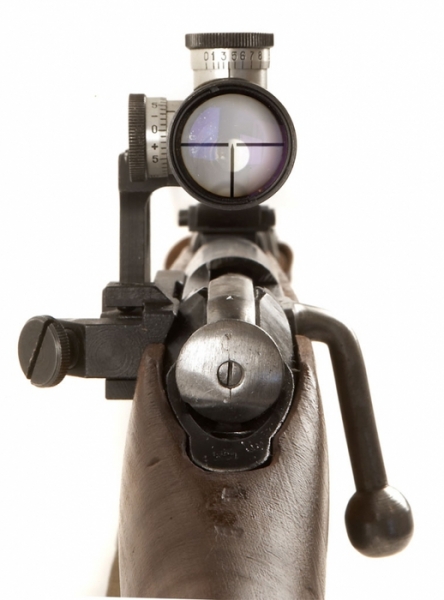
witnesses PU
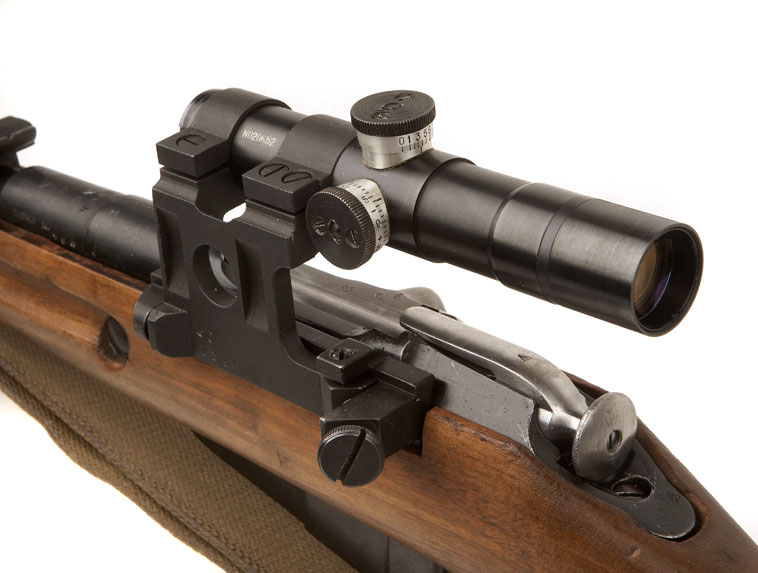
witnesses PU, left view
The rapid development of smokeless powders in a few years essentially devalued results of these studies, that, Nevertheless, We gave a rich and valuable experience, necessary for further development.
Along the way, tested and reduced-caliber rifle (7-8 mm). for example, spring 1885 Colonel Rogovtseva year was set 3.15-line (8 mm) cartridge, created on the basis pereobzhatoy "berdanovskoy" sleeve, intended for firing from the experimental 3.15-linear shafts, developed Armory Department GAU and manufactured in instrumental 2nd workshop Peterburg ammunition plant. Patron Rogovtseva 1885 year to equip an experimental enhanced black powder, with increased nitrate content, which increases its corrosive effects on the barrel, and bullet in the copper core sheathed with lead. He was in charge of 5 grams of powder, who clocked a 13.6-gram bullet to 550 m / s.
In parallel with the development of fundamentally new magazine rifle and were working on the adaptation of the store to an existing rifle Berdan (later recognized hopeless), and - to create a single shot rifles, Use a new cartridge with smokeless powder (not all the military believed the benefits of shopping rifles significant enough for the weapons of the army, which was due to including the absence of the second half of the 1880s clearly successful in relation to the military rifle shop design).

carbine arr. 1938 of the year
Conservatism and waiting attitude, occupied by the military department of the reluctance to repeat the mistakes of 1860-1870 years (when for the period from 1860 by 1870 year was in a feverish manner accepted into service at least 6 different systems for different rifle cartridges, most of them managed to become obsolete, before the start of their mass production), which led to the events, christened the Minister of War D. A. Milyutin "our unfortunate gun drama", resulted in some inhibition of works on creation of the Russian magazine rifle, - what, but, subsequently allowed to avoid unpleasant situations, in which the French were, quickly by adopting the rifle Lebel very quickly made it obsolete rifle magazine, or the British and Austrians, who first took magazine rifles chambered with black powder, and they were soon forced to frantically to alter their smokeless.
Since any weapon created in the first place on the basis of the available ammunition, both were working on a new cartridge.
AT 1886 , Lorenz from Germany was commissioned by the party experienced a reduced caliber ammunition.
AT 1887 year, contacts were made with Swiss professor Heblerom, Materials from which the experiments were obtained, advice and guidance. Hebler advised Anyone who has seen him take the most promising about the caliber 7,6 mm and a bullet in the steel shell, and sent 1000 their patrons with the development of black powder.

carbine arr. 1944 year with non-removable needle bayonet
AT 1888 year in the Russian foreign profits 8mm rifle: Austrian Mannlicher and the Danish Krag-Jorgensen. It revealed, that the Austrian and Danish rifle give better accuracy and precision of battle, than the Commission that have been tested by experienced Russian rifles, but the speed of their bullets were not enough (508-530 m / s) due to the use of black powder, a locking mechanism along with other details rifles was found completely unsatisfactory. The same conclusion was drawn with respect to guns and ammunition Heblera.
At the beginning 1889 year through unofficial channels, the Commission received a French rifle Lebel, use smokeless powder, - with sleeves and bullets, but without most of gunpowder. She also was tested - with Russian smokeless powder. The design of the barrel and bolt rifle were found worthy of attention, however, the tubular barrel-attached store was unsatisfactory.
Russian smokeless powder of satisfactory quality was obtained in 1889 , thanks to the successful experience of D. AND. Mendeleev. In the same year Colonel H. F. Rogovtseva was developed 7.62-mm cartridge on the model of the new 8-mm Austrian M1888, but curb smokeless powder and having a bullet in the casing cupronickel, not so much wear and rust-trunk, the steel, and at the same time more durable, than copper. Proper capsule only appeared 1890 year.
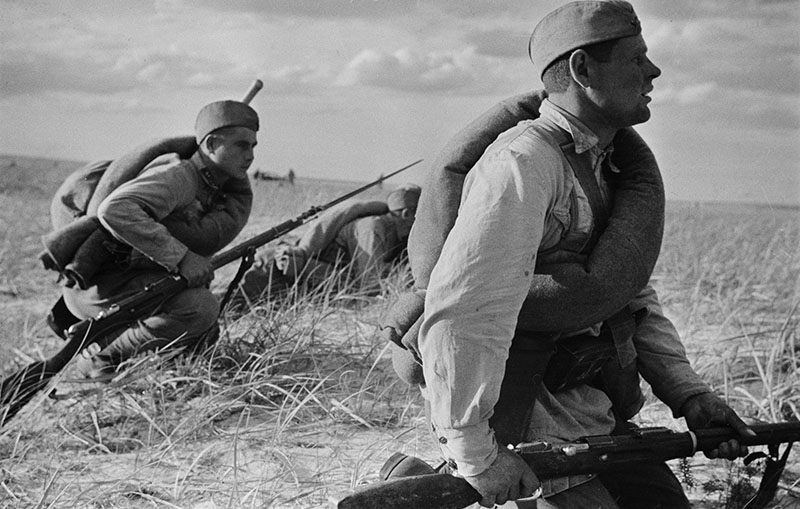
Soviet soldiers in the field during the offensive in the Kharkov area. 1942 year
Although by that time in some countries, in the first place - in which had a very highly developed industrial base in Germany, already been introduced patrons to the ring groove on the sleeve, more compact and convenient to feed from the magazine, Russian patron kept protruding lip, mainly due to the fact, it is possible to produce as a sleeve, and the barrel chamber with large tolerances. Noted and other advantages of the cartridge with rim, - eg, he was more comfortable with loaded magazine or the loading rifles on one cartridge, there was a very real possibility when you exit the store failed or there is no curb ammunition clips, because it is more convenient and faster soldier was pulled out of the cartridge bag. At that time it was not unusual - had the same regular rim French 8 × 50 mm R Lebel, English .303 British (7,7× 56 mm R), American .30-40 power (7,62× 58,8 mm R) and the Austro-Hungarian M1888 (8×50 мм R Mannlicher) ammunition. Only later it revealed the biggest disadvantage of this cartridge for use in an automatic weapon, but this did not prevent some of the above samples remain in service until the end of the Second World War. Furthermore, even in the 1930s in some countries have continued to develop and take advantage of new rifle cartridges with flange, for example cartridge Austrian M30S 8 mm × 56 mod R. 1930 of the year, adopted in Hungary.
However, Even at this stage the question of caliber, apparently, It has not yet been definitively resolved, because soon the study of 6.5-mm cartridge.

Complete disassembly of the Mosin rifle
1 - the barrel to the receiver, 2 - lodge, 3 - handguard, 4 - Store the box with the trigger guard, 5 - tip, 6 - screw tip, 7 - front spring ring lozhevyh, 8 - rear spring ring lozhevyh, 9 - a front ring lozhevyh, 10 - rear ring lozhevyh, 11 - şompol, 12 - shompolnye focus, 13 - bolt nagelya, 14 - nut Nagel, 15 - butt neck, 16 - retaining screws of butt pad (2), 17 - store the bolt, 18 - bolt receiver, 19 - male with namušnikom, 20 - Details sight, 21 - cut-off reflector, 22 - cover box stores and details of the feeder, 23 - cover latch, 24 - details of the trigger, 25 - gate and its parts, 26 - gun belt with two trenchikami.
Creating a rifle
AT 1889 by Sergei Ivanovich Mosin offered on-line-contest (7,62 mm) rifle, worked out on its basis the earlier single-charge, from which it was borrowed almost unchanged slide group and receiver; some ideas on store design at the same time were borrowed from experiencing that same year, the latest of the Austro-Hungarian Mannlicher rifles system with burst loading row middle of the store, which has been recognized fully complies with all the requirements exhibited.
Later, at the end of the same year, Belgian Leon Nagant also invited to the competition your system (in the same 1889 It was already lost in the contest for the Belgian army weapons Mauser rifle). Nagant rifles were three copies, all shops, caliber around 8 mm, although Nagant rifle and took to produce the caliber 7,62 mm. Nagant system has been recognized by the whole benign, but needs some work. Of particular interest to the Commission caused the store to the successful design of the loading of clips, reminding shop just adopted in Belgium Mauser rifle.
As a result of their tests, as well as comparative tests with Austrian rifle Mannlicher, it became possible to finalize the requirements for a new rifle, in modern terms - to make it on the terms of reference. It was decided to take the caliber 7,62 mm (Three Russian line), barrel and sight modeled Lebel (but with a change in the direction of cutting progress with the adoption in France of the left to the right), longitudinally rotary bolt, lockable separate combat larva (since the replacement of the larvae in the case of breakage is less costly replacement of the entire gate), store median, constant, with the loading of the frame of the cage five cartridges. The Commission was therefore in 1889 It was renamed the Commission to produce a sample of small-caliber rifle.
Since no Mosin rifle, Nagant rifle or requirements that are not fully consistent with, designers were asked to elaborate on their basis of new systems, that, in this way, They were originally destined to be largely similar constructive, It is created on the basis of the same trunk developed by the Commission and the cartridge, in a complex determine all the properties of ballistic weapons, and because of the exposed her requirements using the same type of lock and store, and only differences with particular constructive design of these elements. In fact, task was to Mosin revolver and create your own versions of the slide and shops for already existing trunk.
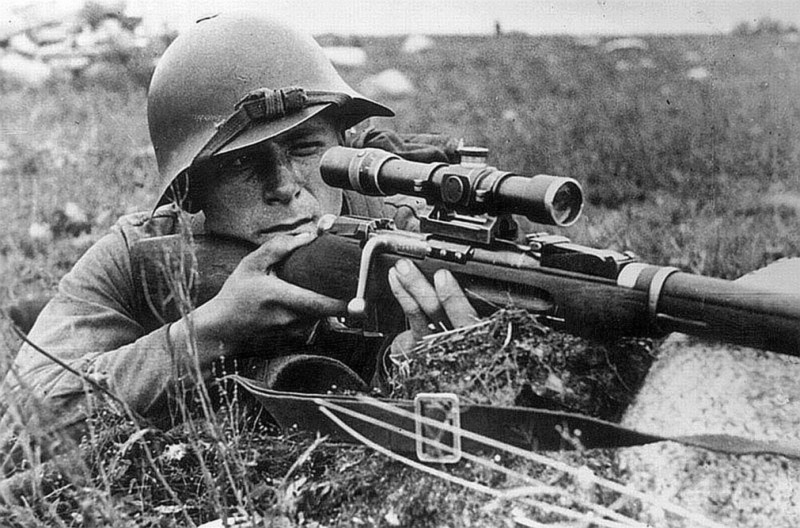
Soviet sniper firing from the Mosin rifle with a sight PE. August 1941 of the year.
simultaneously in 1890 It was considered more 23 system, not showing, but, advantages over the already selected for further comparison Mosin Nagant and.
After delivery of the Belgian pilot batch of modified 3-Nagant rifles linear autumn 1890 , began large-scale comparative test of both systems.
According to the initial results of the tests Nagant rifle showed a slight advantage, and the first stage of the competition, the Commission voted in favor of it 14 votes to 10. However, This vote was not decisive, as the first stage of the contest wore on fact-finding character. Also, Many members of the committee considered, tests have shown that the equivalence of the submitted samples - this design Mosin preliminary assessment in their view was mainly related to a lower quality finish than with demonstration samples Nagant, while the Mosin rifle was generally easier and safer to constructively. The difference in quality finish also was quite natural, given the fact, that the Mosin rifle at that time were made in the ordinary semi-artisan conditions prototypes of weapons, located at a very early stage of finishing - while, as those presented for comparison with them Nagant rifle, filled "with amazing accuracy" and very well decorated, It is a further development of the structure, at one time been submitted for the competition in Belgium and ready for mass production as early as 1889 year. Furthermore, it was written, what:
Pay attention to, ... provided that the captain Mosin rifle on experiences and clips were made when conditions are extremely unfavorable, and due to very inexact, guns and the clips Nagant, on the contrary, It was made amazingly accurate, Lieutenant General Chebyshev did not find it possible to agree with the conclusion, both tested systems are equally good. In his opinion, view of the above circumstances,, Captain Mosin system had a huge advantage.

Various embodiments infantry rifles Mosina.
Read more about the results of the two systems and military trials (tested 300 Mosin rifles and 300 Nagant rifles), Commission members reviewed the opinion. On test firings Mosin rifle given 217 delays in the supply of cartridges, and Nagano - 557, almost three times more. Given the fact, that competition essentially comes down to finding the optimal design of the store, one is quite clearly talk about the benefits Mosin system in terms of reliability, regardless of any "adverse conditions". Besides, The Commission concluded, what:
... Nagant rifles burst foreigner in comparison with the same cap. Mosina is a mechanism more complicated for manufac ... itself the value of each instance of guns undoubtedly increase.
And it was about more than material costs: even by the most conservative estimates, Nagant production system would enable the additional costs in the amount of 2 to 4 million gold rubles for the first million issued rifles, that is, 2-4 ruble each, though, that the total, required for rearmament of the Russian soldier, It averaged about 12 rubles. Besides, require additional 3-4 months on the development of construction industry, in an already incipient backlog of Russia from the developed European countries to re-new small arms, though, Mosin rifle that is already ready for production and was specifically designed for a high degree of continuity with the technology already produces rifle Berdan.
So that 1891 year, upon completion of military trials, The Commission drew up a compromise solution: adopted a rifle, developed on the basis of design Mosina, but with significant changes and additions, like structures borrowed from Nagano, and taking into account the proposals made with the members of the Commission itself.
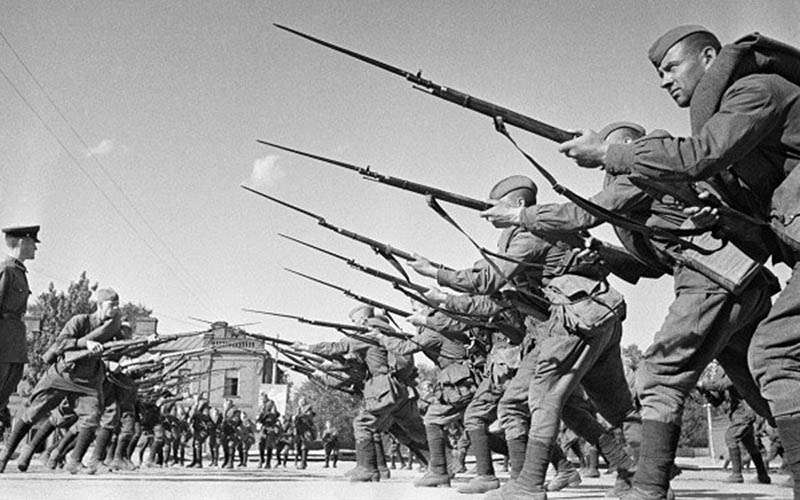
Red Army fulfill skills bayonet.
From experimental rifle Mosin directly strap locking mechanism used therein were, safety cocking device, prison, cut-off reflector, latch the magazine cover, method of connecting the feeder with a lid, giving the opportunity to detach the cover from the feeder from store, sling swivel hinge; Nagant from the system - the idea of space to store the feeder door and opening it down, the way descent store filled cartridges out of the cage finger, - Consequently, slots for clips in the receiver and, properly, she CLIP STRIPS. The rest of the members of the Commission have been developed, with the participation of Mosina.
changes, borrowed from Nagant rifle (form holder for loading, mount feeding spring to store lid, cut-off reflector form) somewhat increased ease of handling a rifle, but even in case of their removal has not been deprived of its functionality. for example, if you opt out of oboymennogo loading, shop can equip one patron. If you disconnect the feeding spring from the magazine cover, ammunition will continue to be made, at increased risk of losing the spring when cleaning. In this way, the role of these changes is secondary to the purpose and functioning of the weapon and does not give grounds for refusing to recognize the Mosin Nagant author or place name in the sample name, without mentioning other authors, equally important, than borrowed from his system, additions.
probably, fully reflects the authorship of the design of this rifle would be called "Commission of the sample rifle 1891 of the year", similar to the German "comission rifle" (Kommissionsgewehr) sample 1888 of the year, also produced in due time by the Commission on the basis of systems and Mannlicher Mauser.
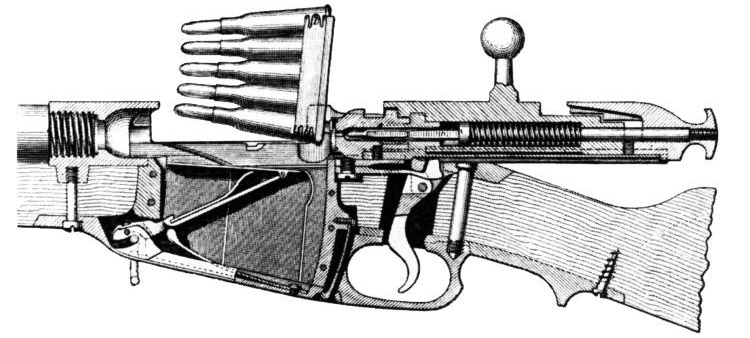
The position of impact of parts and the trigger at the rearmost position of the shutter.
The authorship of the new rifle is absolutely clearly formulated, the then Minister of War II. FROM. Vannovsky in its resolution on the adoption of the sample into service:
The manufactures are part of a new sample, Colonel proposed Rogovtseva, Commission Lieutenant General Chagin, captain Mosin and gunsmith revolver, so it is advisable to give the name of the model worked out: Russian 3-lin. sample rifle 1891 of the year.
16 April 1891 the Emperor Alexander III approved the sample, deleting the word "Russian", therefore adopted the rifle was adopted under the name of "sample-line-rifle 1891 of the year".
For Mosin left of the right to individual parts of the rifle developed by him and awarded him the Grand Prize St. Michael (for outstanding development of artillery and rifle parts).
It was not the first case, when the sample, created on the basis of a specific system with extensive additions, He is taken to the Russian army under the impersonal index, without mentioning the name of the author of the original system; eg, rifle, worked out on the basis of Karl system (in the original Russian documents - Charles), at 1867 It was adopted as a "quick-needle sample rifle 1867 of the year".
later, but, were voices that, What is the name of a well-established tradition of naming violated firearms Russian army samples, as the constructor name was deleted from the name adopted by sample arms. Eventually, at 1924 year appeared in the name of the Mosin rifle title.
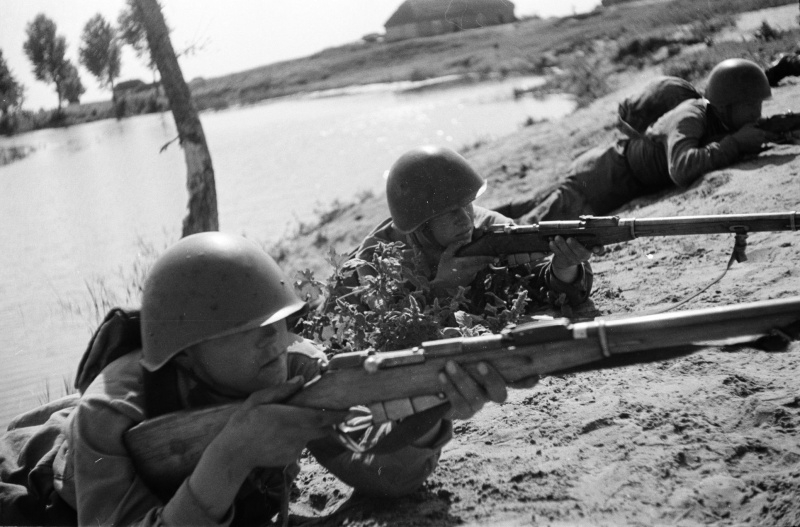
Red Army soldiers with rifles Mosin took the firing position after crossing the river.
Wherein, and in the Manual 1938 and reprint 1941 of the year, in the brochure for Osoaviahima 1941 year "rifle and its application", and in the Manual 1954 year rifle (in the embodiment, after upgrading 1930 of the year) It called simply - "arr. 1891/30 years. ", without mentioning any names, - though, that refer to other models (autoloading rifle and shotgun F. AT. Tokarev, Submachine Gun D. FROM. Špagina and A. AND. Suda and others.) in a similar literature almost always annotate type "design of such a" or "system such a". In this way, probably, that in this period officially in relation to the rifle continued to use the "impersonal" name over the years of its adoption on arms. The admonition from 1938 authorship, the rifle is also indicated directly:
7,62-mm. arr rifle. 1891 city, adopted by the Russian army in 1891 city, It was constructed captain Mosin together with other members formed for this commission.
- i.e, just points to the "commission" origin rifle design, although not mentioning directly on individual borrowing from Nagant system. Abroad, beside the name of the Mosin Nagant often put a name, as well as in the names of pistol "Tokarev-Colt" and "Makarov, Walter».
Production and operation
rifle production began in 1892 year on Tula, Izhevsk and the Sestroretsk arms factories. Due to the limited production capacity of these plants, an order for 500 thousand rifles were placed on the French arms factory in Chatellerault (National Factory of Châtelleraut Weapons).
The first combat test Mosin rifle was held in 1893 year in a clash of the Russian squad in the Pamirs with Afghans, according to other sources - in the course of suppressing the Boxer uprising ("Boxers") in China in the years 1900-1901.

Polish carbine M91 / 98/25 under the cartridge of 7,92 × 57 mm Mauser
In the first years after the adoption of the rifle into service, during the production and operation of weapons to the original design have begun to make changes. So, at 1893 year introduced a wooden handguard to protect the hands from burns arrow, at 1896 year - new ramrod, a longer and larger-diameter head, not passing the barrel, making it easier to clean weapons. Eliminated the notch on the sides of the lid box stores, which when worn weapons wiped uniforms. These improvements have contributed to the design and previously issued rifles.
21 Martha 1897 , the 500,000th rifle was released. At the end 1897 the first phase of upgrading the Russian army rifle arr. 1891 g. It was completed and 1898 year began the second phase of re.
By the beginning of Russian-Japanese war, the army was put about 3 800 000 rifles.
The Japanese responded to the shortcomings of his rifle, discovered during the war of 1904-1905. They are very carefully examined his rifle and eliminate almost all defects, undeterred by the necessary for this purpose monetary costs. practically, I had to make the rifle of the new system. Japanese industry was flexible enough, to quickly and well to cope with the challenges it faces - to give as soon as possible a better rifle. Otherwise, the situation was in Tsarist Russia. Although the war of 1904-1905. also confirmed in the Russian rifle number of shortcomings, but the Defense Ministry did not dare to make any changes rifle, requiring cash outlay. Technically backward factories still stubbornly defended with difficulty adjusted manufacture of the old rifles samples. It was ignored by the blood of the experience. As a result, Russian rifle left behind by the Japanese.
After adopting in 1908 , the cartridge with a pointed ("Nastupatelnoy") bullet in 1910 year adopted a new version of the rifle was adopted with a view Konovalova system, accordingly ballistics new cartridge. New bullet weighed 9,7 r and produced an initial speed of Cossack rifles - 850 m / s, of Infantry - 880 m / s. Cartridge weight - 22,55 g.

Finnish M39 carbine, pistol butt neck.
As a result of the outbreak of war 1914 g. Japanese military were almost first-class rifle, Russian army has remained the same with a rifle, inferior to German, Austrian and Turkish rifles, tenacious enough and with a reduced rate of; rifle still had constantly fixed bayonets, harmful to marksmanship.
By the time of Russia's entry into the First World War on the Russian Army had 4 519 700 rifles, in the production are four options for rifles - Dragoon, Infantry, Cossack and carabiner. During the war, Russian military industry has produced 3 286 232 -line-rifles, otremontirovala and corrected 289 431.
Due to the catastrophic shortage of arms and internal problems of the industry the Russian government began to buy abroad rifle several foreign systems, as well as ordered in the United States at the Remington and Westinghouse companies 1,5 million rifles arr. 1891/10 gg. Some of them had never been put Russia - after the Revolution, the US government confiscated their. Today Mosin rifle of American production - one of the most rare and represent the greatest collection value, along with rifles, Manufactured in France in Chatellerault. Due to all of the same lack of weapons had even arming shooters imported weapons under a non-standard chuck - so, according to the memoirs gunsmith Fedorova, the whole Russian front with North 1916 , I was armed with a 6.5-mm rifles Arisaka, supplemented by a minor amount of use the same cartridge "machines" (automatic rifles) system of Fedorov, available to the selected shooters in the composition of company.
A large number of rifles were captured by German and Austro-Hungarian troops.
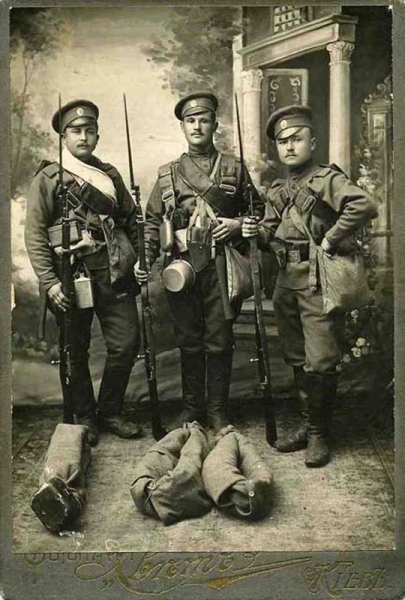
The essential rifle deficiencies have been identified during the war in what was then its form, primarily associated with the failed structures clips, reduces the rate of fire on the battlefield, and fitting-out of individual elements, such as a bayonet mount with a collar, Device shompolnye abutment rings or constructions lozhevyh, that in a direct comparison with the German and Austrian samples left a very bad impression. The greatest number of problems, but, taken lag domestic industry and in the manufacture of extreme rush rifles prewar, due to which each of them require careful fitting parts and debugging to ensure the reliable operation, It exacerbated by the recent transition to a peaked cartridges, more demanding work feeder, as well as the inevitable conditions of trench warfare heavy pollution as the rifles, and ammunition. Taken from stock and transmitted to the front without a rifle refinement gave many delays during reloading, some of them could not shoot, and one full magazine without disrupting supply. It was revealed numerous drawbacks organizational, in the first place - disgusting training ordinary shooters and poor supply, in particular, the lack of quality of packaging sent to the front cartridges.
During the Civil War are two types of rifles made in Russia - and Dragoon, in much smaller quantities, Infantry. After the war,, from 1922 of the year, made only Dragoon rifle and carbine arr. 1907 of the year.
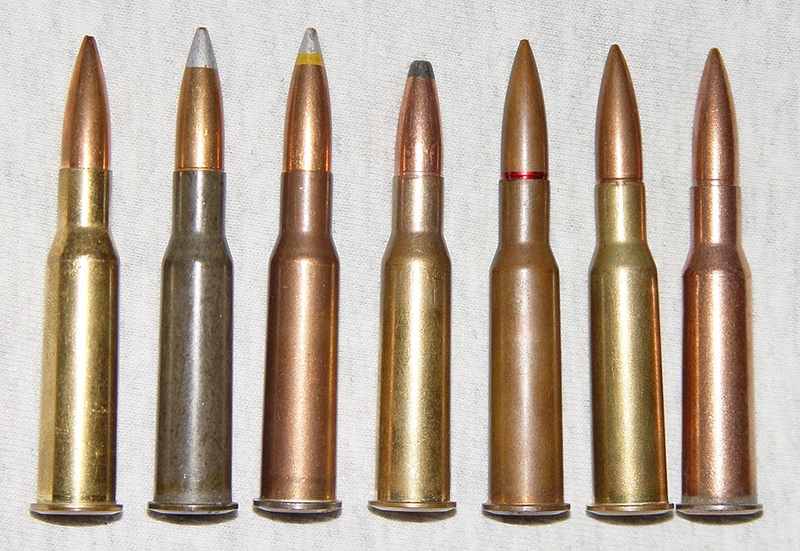
Cartridges 7,62 × 54 mm in the range R (tardive modification with spiky bullets, bullets were originally round toes).
In the first years of Soviet power started a broad discussion about the feasibility of upgrading or replacing the existing sample rifle more perfect. it was concluded in the course of its, the rifle arr. 1891 of the year, while giving a new foreign analogues, subject to a number of improvements still quite satisfied with the existing requirements for this type of weapon. It was also noted, that the introduction of a new model of shopping rifles would be essentially meaningless, since in itself repeating rifle is rapidly becoming outdated type of weapon, and the cost of developing its fundamentally new model would be a waste of resources. Besides, It noted, that the change of rifle sample must necessarily be accompanied by a change in the regular rifle cartridge with a new, devoid of the disadvantages of the-line-, in particular, having a smaller size with greater transverse load a bullet and the sleeve without the collar - the development of an entirely new sample under rifle cartridge obsolete also regarded as having no meaning. In this state of the economy, still comes out of the post-revolutionary chaos, does not give grounds for optimism about the possibility of such a large-scale re - as proposed Fedorov complete retooling of the Red Army automatic (samozaryadnoy) rifle. The introduction of semi-automatic rifles in addition to the existing store itself Fedorov considered useless, as it turns out at the same time gain in firepower infantry squad was negligible - instead, he recommended that, while maintaining the current magazine rifle sample complement its large number of hand-held light (in his terminology - "maneuvering") guns again generated a successful sample.
Following the discussion in 1924 he was a committee to modernize the rifle arr. 1891 of the year.
Ammunition for the rifle, Curb in the cartridge holder.
As a result of modifications Dragoon embodiment rifles, as short and easy, there was no single model - the sample rifle 1891/1930 gg. (Index GAU - 56-V-222). Although it contained a whole series of improvements relative to the original sample, compared to peers, available anywhere in the armies of states of potential enemies of the USSR, She still did not look in the best way. However, repeating rifle at that time was no longer the only kind of small arms infantry, so at that time the bet was made in the first place to create a more modern and perfect of its species - submachine gun, pulyemyotov, and self-loading rifles.
In the 1920s - 1930s in the USSR, Mosin rifle used in the system and Vsevobuch OSOAVIAHIM for training in shooting, widespread movement "Voroshilov shooters".
AT 1928 in the USSR was launched serial production of the first samples of optical sights, specially designed for installation on the rifle arr. 1891 of the year.
AT 1932 year also started mass production of a sniper rifle arr. 1891/30 gg. (Index GAU - 56-V-222A), wherein the improved processing quality bore, presence of optical sight PE, PB or (later) PU handle and bent down shutter. All were released 108 345 PC. sniper rifles, They were used extensively during the Soviet-Finnish and the Great Patriotic War, and established themselves as a reliable and effective weapon. Currently, sniper rifles Mosin are collector's value (especially the "nominal" rifle, which is awarded to the best Soviet snipers).
AT 1938 he was also received upgraded similar basic pattern carbine arr. 1938 of the year, represents a modification of the sample carbine 1907 of the year. He became longer than its predecessor 5 mm and was designed to conduct aimed fire at a range of 1000 m. Carbine was intended for various types of troops, in particular artillery, sapper troops, cavalry, communication units and employees of logistical, such as transport drivers, which it had to be light and easy to handle weapons mainly for self-defense.
prison Mosina
The last option was the carbine rifle arr. 1944 of the year, distinguished by the presence of non-removable needle bayonet, and a simplified manufacturing technology. Simultaneously with its introduction of the sample itself rifle 1891/1930 gg. with the production was filmed. Shortening of infantry weapons was imperative, advanced experience of the Great Patriotic War. Carbine has enhanced maneuverability infantry and other combat arms, because with him it became easier to fight in various earthworks, buildings, thickets, etc.. P., And the fighting qualities of his in shooting, and almost fell into the bayonet than with a rifle.
After adopting in 1938 was quite successful semi-automatic rifle Tokarev (SVT), anticipated, that in the early 1940s, it almost completely replaced in the Red Army Mosin rifle and become the main weapon of the Soviet infantry, followed by the US Army, take in the 1936 was adopted automatic rifle Garand. According to the plans in the pre-war 1941 It was supposed to be released 1,8 million. SVT, at 1942 — 2 million. In fact, when the war was made over 1 million. SVT, and many units and formations of the first line, mainly in the western military districts, We received a number of staff self-loading rifles.
However, a full re-Red Army plans with automatic weapons have not been implemented due to the outbreak of the Great Patriotic War - from 1941 , the production of CBT as a more complex compared to the repeating rifle and submachine gun has been reduced several times, and one of the main weapons of the Soviet Army remained an upgraded rifle arr. 1891 of the year, although complemented very substantial amounts (more than half of the total number of small arms at the end of the war) self-loading rifles and submachine guns.
AT 1931 year produced 154 000, at 1938 year - 1 124 664, at 1940 year - 1 375 822.
Equipment shop rifle out of the cage.
AT 1943 year in the occupied territory of Belarus railway engineer T. E. Shavgulidze developed design 45mm rifle grenade, total, in 1943-1944 in the workshop of the Minsk partisan connections Soviet partisans were made 120 rifle grenade Shavgulidze system, which were installed on the Mosin rifle.
Manufacture of basic rifle arr. 1891/30 gg. It was discontinued at the beginning of 1945 of the year. carbine arr. 1944 Year manufactured until the beginning of the production of Kalashnikov assault rifle. Rifles and carbines are gradually removed from army weapons, replacing the SKS carbine and a Kalashnikov (although some rifles arr. 1944 year, we continued to use the system of militarized guard).
AT 1959 Izhevsk plant was shortened barrels and boxes remaining rifles arr. 1891/30 gg. to the size of a carbine arr. 1938 of the year. The "new" carbines were issued in large numbers, and entered service the private security and other civil society organizations. In the West, they were designated 1891/59.
Mosin rifles and carbines continued to be used in the armies of Eastern Europe and around the world a few decades. As an infantry weapons and fighters of irregular armed groups Mosin rifle used in many wars - from Korea and Vietnam to Afghanistan and conflicts in the post-Soviet space.
grenade Dyakonova
Design and function
The barrel and receiver
Rifle barrel - rifled (4 groove, climbing up to the left-to-right). Early samples of the trapezoidal shape of rifling. Later, when seen, metal slug that galling does not occur on the trunk, - a simple rectangular. caliber barrel, measured as the distance between the opposing fields rifling, nominally equal to 7,62 mm, or 3 Russian lines (really, as shown by measurements, conducted on a large number of rifles of different years of release and various states of preservation, - 7.62 ... 7.66 mm). By rifling caliber is 7.94 ... 7.96 mm.
In the rear part of the barrel located chamber with smooth walls, designed for cartridge space in the shot. With the threaded portion of the barrel it is connected by means of pooling entry. Above the cartridge chamber is located manufacturer's trademark, allowing to identify the manufacturer and the year of issue rifle.
The back of the trunk of a tree stump, having a thread, tightly screwed receiver, which serves to space the shutter. To her, in its turn, attached shoplifting box with feeder, cutoff reflector and the trigger.
Box stores and cut-off reflector
Magazine case (score) It serves to space 4 cartridges and feeder. It has cheeks, elbow, trigger guard and the cover, on which is mounted a feeder.
The cartridges in the store are arranged in a single row, in this position, their flanges do not interfere with feeding, Why it is unusual by today's standards store form.
Trim deflector-controlled shutter movement and serves to separate rounds, supplied from a store in the receiver box, preventing possible delays when filing, caused by the engagement of the flanges of cartridges for each other, and also plays the role of a reflector shoot sleeves. Before upgrading 1930 , she was a single piece, After - it consisted of blades with reflective protrusion and the spring portion.
The cut-off reflector is considered one of the key design rifle parts, entered Mosin, ensuring the reliability and uptime of weapons in any conditions. At the same time, its very presence was due to the use of obsolete ammunition with lip, not very comfortable to be fed from the store.
However, Even stores Lee system, taken to the British rifles Lee-Metford and Lee-Enfield, also use a cartridge with a rim, We did not have a cut-off reflector, instead of which store had the spring sponge top and a diamond shape in profile, through which the cartridges were placed in it so, that rim the top of the cartridge to stand in front rim followed by a, and engage them was excluded (Christmas Tree). It is this scheme in the future become common for stores under rantovoy (having a rim) ammunition.
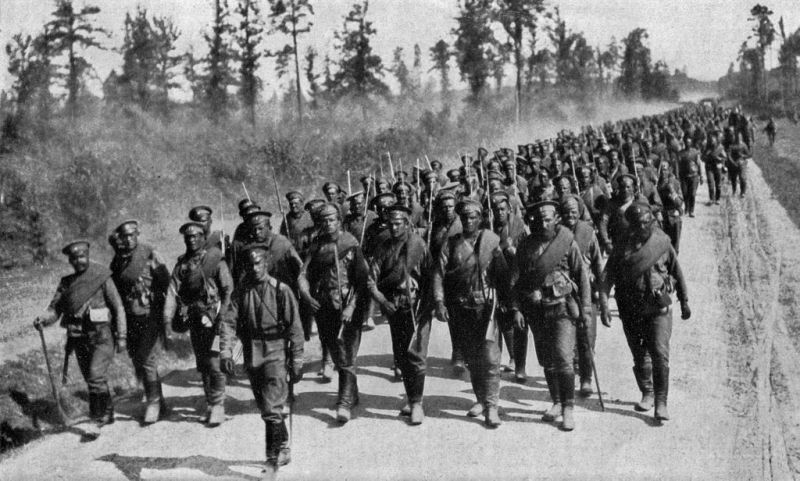
Russian infantry on the march. It is seen, that most shooters bayonets join.
trigger
The trigger mechanism includes a trigger, trigger spring, serving as the sear, screws and studs. Descent rifle - long, tight enough and without the "warning", - i.e, move the trigger is not divided into two stages with differing force.
prison
Bolt-action rifle used for chambering a cartridge in the chamber, locking the barrel when a shot, the shot, Shoot extraction sleeve or cartridge from the chamber Osieczna. It consists of a stem with a comb and a handle, Battle larvae, ejector, chicken, drummer, the mainspring and the connecting strap. On the sniper rifle elongated handle and bent down shutter to improve convenience reloading arms and the possibility of installing an optical sight.
The gate has a cylindrical firing pin and firing pin spring twisted. Compression mainspring occurs when unlocking rotating bolt handle; when locking - cocked firing pin rests on the sear. Perhaps cocking the hammer manually closed gate, To do this, pull back the hammer (in this case the trigger is called tip, screwed onto the shank of the hammer). To arm the trigger guard is necessary to pull back to the failure and turn counterclockwise.
stock, handguard
Lodge connects parts of the weapon, it consists of the forearm, neck and butt. Lodge rifle Mosin-piece, birch or walnut. The neck is straight Lodge, more durable and suitable for bayonet fighting, although less convenient when shooting, than semi-pistol neck lodges many later models. FROM 1894 g. introduced separate part - handguard, which covers the top of the barrel, protecting it from damage, and hand arrow - burn. Butt dragoon several modifications already, and forearm thinner, than Infantry. Bed and handguard are attached to the mechanism of the weapon by means of two screws and two rings with lozhevyh kolechnymi springs. Lozhevyh split ring to the primary mass and rifles on deaf dragoon arr. 1891 of the year.

Soviet soldiers shoot at enemy aircraft, June 1943 of the year.
Sights
Consisted of sight and the front sight.
Sight - a step on the rifle arr. 1891 of the year, sector on the rifle arr. 1891/30 of the year. It consists of a sight leaf with a collar, Spot spring pads and. Rifles Countdown. 1891 , the aim was to calibrate hundred paces. On the rib had two pillar: one was used when shooting at 400, 600, 800, 1 000 and 1 200 steps, and second, for which it was necessary to raise the rear sight in the vertical position, - at a distance of 1 300 to 3 200 steps. Also, there were two versions of the framework of sight: the original version, used before 1910 year and designed for heavy bullet, and modernized, Konovalova with strap system, designed for an easy pointy "aggressive" bullet cartridge arr. 1908 of the year. Rifles Countdown. 1891/30 s sight is marked up in the distance 2 000 m; the only rear sight can be mounted in any position on the 50 to 2 000 m increments 50 m.
The front sight is located on the barrel near the muzzle. U rpm. 1891/30 s got a ring namushnike. AT 1932 year began mass production of the sniper rifle arr. 1891/31 years (Index GAU - 56-V-222A), wherein the improved processing quality bore, presence of optical sight PE, BOP or PU and bent down bolt handle.
Bayonet
It serves to engage the enemy in close combat. It has a four-sided blade with fullers, tube with a stepped slot and spring latch, securing the bayonet to the barrel, and connecting their neck. The rifle was reduced to a normal battle with bayonet, i.e, when shooting, he was supposed to be adjoined, - or the point of impact significantly shifted and the relatively long distance to get a weapon into something new, without reduction to normal battle became almost impossible. When shooting with a bayonet at a distance 100 m the middle point of contact (STP) deflected by the reduced to the normal battle without his rifle on the left 6-8 cm and down to 8-10 cm, It offsets put back to the normal combat.
At all, bayonet was supposed to be on the rifle in fact constantly, including the storage and on the march, except for movement by rail or road. Manual remov- bayonet, in addition to the above mentioned cases,, only when the rifle disassembled for cleaning, where it is assumed, that from a permanent location on the weapon, he can hardly be removed. To 1930 , the spring latch has not been, instead of what a bayonet was attached to the barrel by means of a bayonet clamp, blade shape is also somewhat different. Experience has shown, that over time, such a compound is prone to loosening. AT 1930 , the method of attachment changed, but the rifle still were shot with bayonets. Part of the upgraded rifles also had a bayonet namushnike (earlier version), namushnike later we began to do at the very rifle.
carbine arr. 1944 year was integrally cast rocker bayonet own sample design Semin. Zeroing is carried out with a bayonet rifles in firing position.
Belonging to the rifle
On each rifle relied affiliation, consisting of wiping, otvёrtki, muzzle covers for cleaning the barrel, shompolnye clutch, studs, bristle Yorshik, lubricators with two compartments - for the cleaning solution trunks and oils, as well as gun belt.
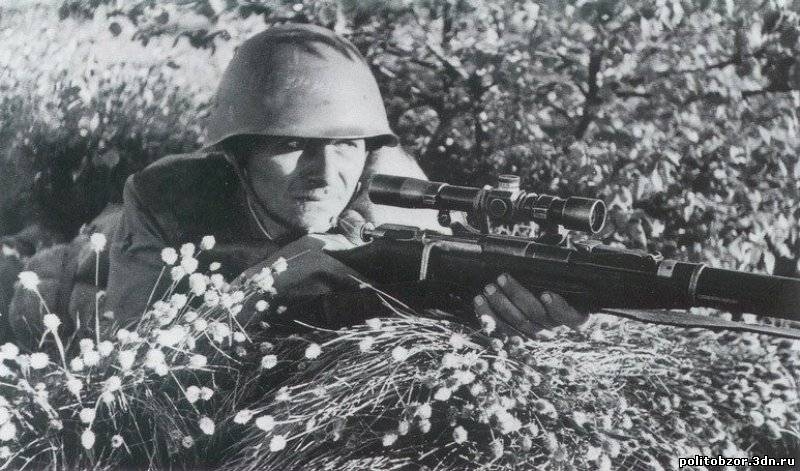
Operating principle
For loading the rifle must be:
– Rotate the handle to the left shutter;
– Take the bolt back to failure;
– Insert the holder into the slots of the receiver; drown cartridges and discard the clip;
– Hand in these forward shutter;
– Turn the knob to the right shutter.
After this the rifle immediately ready for production shot, for which the arrow can only pull the trigger. For the production of the next shot to repeat the points 1, 2, 4 and 5. Four cartridges out of the cage are served in the shop, and the top remains in the receiver, separated from the rest of the cut-off blade, and when closing the shutter shall be sent to the chamber.
The order of partial disassembly
– remove the bolt, for what, the trigger pulled, rotate the knob to the left and upward to the end pull back.
– remove the bayonet.
– Unscrew and remove the ramrod.
– Separate the cover box stores.
– disassemble the bolt.
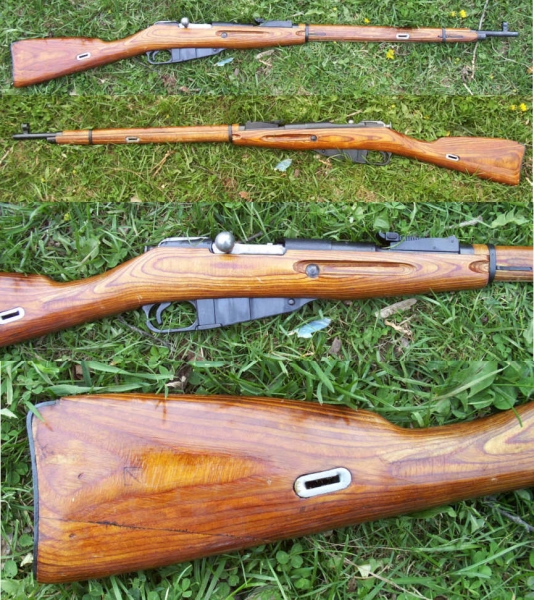
rifle model 1891/30 years.
Accuracy and efficiency of fight fire
rifle arr. 1891 and 1891/30 It has been a high-precision weapons, allowing to strike a single target at a distance of up to confidently 400 m, sniper using optics - up 800 m; group - at a distance of up to 800 m.
AT 1946 year veteran of the Great Patriotic War Sergeant Germans developed a method of high-speed rifle shooting. At the landfill Ryazan infantry school, he was able to make a rifle 53 aimed shots per minute from a distance 100 meters on the chest of the target, hitting it 52 bullets. In the future, the method of high-speed shooting Nemtseva became widespread in the armed forces.
Sniper rifles Mosin prewar production differed amazing, by the standards of his time, quality battle, thanks in part to the trunk with chokom (narrowing the channel from the Treasury to the muzzle), with a difference in diameter of the breech and muzzle parts 2-3 %. When fired from the barrel of the bullet further crimped, that does not allow her to "walk" on the channel trunk.
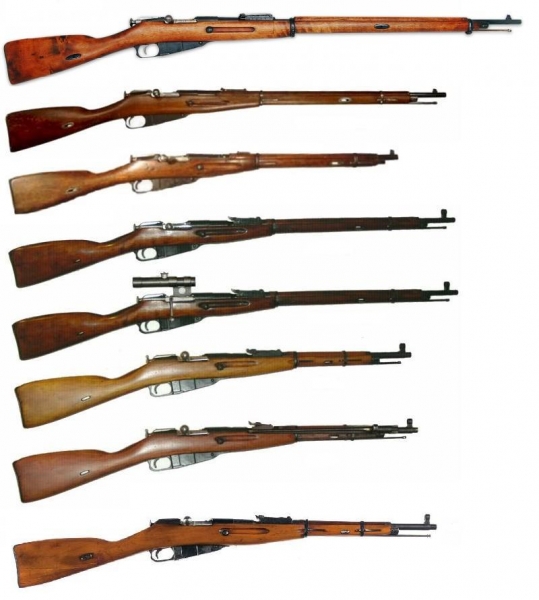
Various modifications rifles and carbines Mosina
Advantages and disadvantages
dignity
– Good ballistics and high capacity cartridge (at the level .30-06), though, many analogues at that time still used black powder;
– Large survivability barrel and bolt;
– Low demands on the manufacturing technology and large tolerances;
– Reliability, reliability mechanisms of action rifle in any conditions;
– A simple and reliable design of the shutter, of just 7 parts; he assembled and disassembled quickly and without any tools;
– Box store well closed bottom;
– Strong box and butt;
– Cheap Framework clip;
– Easily removable for cleaning the shutter;
– Sufficient rate rifles;
– Separate combat shutter larva, replacement in case of breakage which is much cheaper, than replacing the entire shutter;
– The cheapness of the replacement of wooden parts.
disadvantages
– Outdated cartridge with rim, impedes flow from the store and require administration essentially superfluous otherwise, rather difficult to manufacture and vulnerable to damage parts - the cut-off reflector (later in the course of modernization is replaced by two simpler to manufacture parts; Nevertheless, stores the most advanced systems provide a reliable supply of cartridges with a flange and without a cut-off as a separate component, eg shop Leigh system for rifles Lee-Metford and Lee-Enfield dual inline cartridges, which allowed to increase the capacity of the store with a rifle 5 to 8-10 rounds);
– The horizontal arrangement of lugs in locking bolt head, increasing dissipation; rifle with the best fight at that time already had a vertical arrangement of lugs with a locked gate;
– Long and heavy descent without the "warning", interfering marksmanship;
– Framework nepruzhinnaya clip, complicating loading; already existed at the time the spring plate holder, including clip Mosin, It was perfect, though more expensive adopted Nagant clips;
– Long and extremely outdated needle bayonet with a bent neck, mountable on the barrel, not the bed;
– Infantry and Dragoon rifle with a bayonet targeting, i.e, when shooting, he had to be on the rifle, otherwise the point of impact significantly shifted, It is making ready for battle weapon cumbersome; bayonet chatter over time, whereby the accuracy of the rifle fire fell; Cossack rifle targeting without bayonet, but still it was too heavy, and generally uncomfortable for shooting from a horse and wearing Connick; LOOSE bayonet eliminated on arr. 1891/30, bayonet but still had to be on the weapon during firing; completely solved this problem was only a carbine arr. 1944 , the introduction of the integrally cast rocker bayonet, which with the shooting also remained on weapons, but could emerge, increasing ease handling;
– short, is not bent to the bottom bolt handle, complicates its opening, especially when the liner tight "stuck" in the chamber; strong take-away handle forward because of the construction gate and its horizontal position without bending down, forcing the shooter to take away from the shoulder with the butt of reloading, reducing the rate of; (except sniper modifications, had a longer handle, I bent down); advanced samples of those years have already had staked much back handle, I bent down, allowing reloading, without taking away from the shoulder butt, thereby increasing the rate of, - a reference in this regard may be considered hilt Lee-Metford rifles; It is worth noting, that experienced Mosin rifle 1885 of the year, and rifle Nagano had staked handle back gate, located in a special recess, Separated from the window to eject spent cartridges jumper, that more and reinforces the receiver box; however rifle trials 1885 It was found out, that with such an arrangement, the handle occur frequently delays when reloading, caused by the, that a soldier's overcoat long sleeves fall between the gate and the stem receiver, and from a separate cutout for the handle we felt it necessary to give, returning to the same configuration of the receiver, as rifle Berdan;
– Direct neck butt, less comfortable with thoughtful shooting, than semi-pistol at the latest at the time the samples rifles, although more convenient when shooting offhand, as well as more robust and easy-to-bayonet;
– fuse Mosin, - very simple, but inconvenient to use and malozhivuchy due shredding relief protrusion frequent use (how much do we need to guard repeating rifle - a moot point);
– A backlog of advanced foreign counterparts in the decoration of small parts and accessories, for example - and quickly outdated loosens lozhevyh ring, vulnerable to shocks sight, less convenient, what side, lower "infantry" sling (from 1910 Year replaced by also not the most convenient slots for passage of the belt, initially available at the Dragoon rifle), inconvenient abutment ramrod and t. d.;
– Low quality of wooden parts due to the use of cheap wood, especially in the later editions.
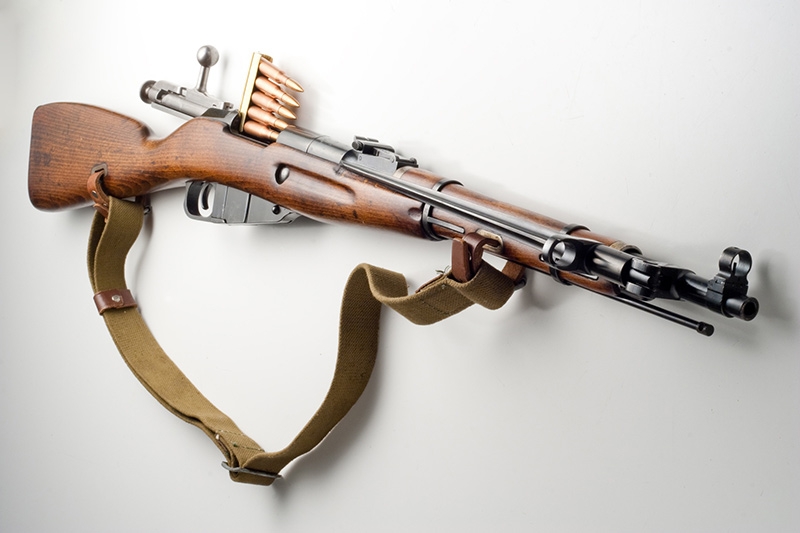
options
Carbine put into service in the twentieth century (1907 city) It corresponds to the development of technology late nineteenth and had numerous disadvantages. Russian carbine on the device and ballistic properties turned out to be worse than the foreign rifles, while standing on arms. All this soon proved to be true in World War II. It turned, that adopting almost simultaneously with the Russian German, Turkish and Japanese carbines new model were perfect Russian carbine. Much better was the Austrian carbine.
Many defects carbine was not difficult to eliminate in the design of this weapon. The trunk should have done but drawing the trunk well-known at the time the rifle Lyuttsau, converted from infantry rifles Mosin. Carbines Lyuttsau differed excellent accuracy of the battle and successfully used initially for the grand hunts. bolt handle should make longer and lower it down. Example - handle French, German, English and other carbines. The fuse can be made more user-friendly. Example - old Berdan fuse or fuse Schmidt-Rubin rifle Swiss. Arrange descending from attentive. Sight strengthen modeled sight Boer carbine "Mauser". Fly to protect the side wings (example - English, German and other carbines). Box to make the neck of pistol shape. Handguard harden. Lozhevyh ring modeled on Lee-Enfield, or Boer, Spanish or other carbines. Ramrod strengthened rifle is not threaded, and on the latch (Example - Japanese carbine). For convenience and speed of loading had to be in the left side of the receiver, in front of the slot for the holder, make a groove for the thumb. Example - German sample Rifle 1898 g. The introduction of these improvements would significantly increase the positive qualities, eliminating defects carbines simultaneously.
Carbine Mosin sample 1907 g. It was issued by Russian police, then the soldiers machine-gun mouth and Ulan, partly - in the artillery and denoted team, and 1914 g. - in some Cossack regiments. Cossacks during the war on their own and soon replaced their foreign trophy carbines - Austrian, German or Turkish.
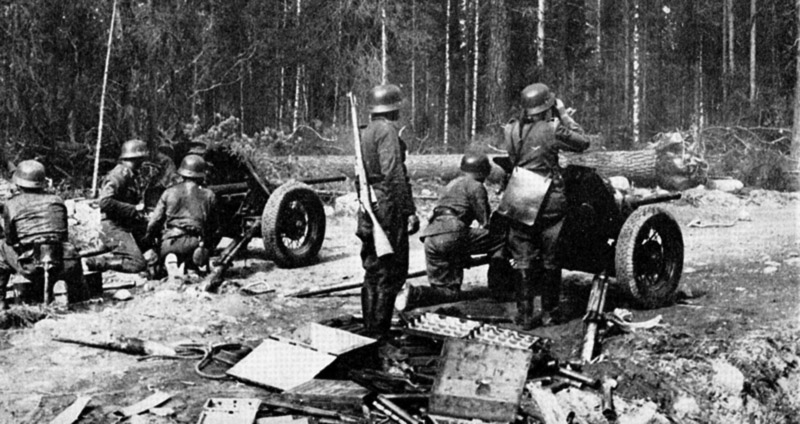
The Germans were firing from cannons captured Soviet. The soldier at the center of a trophy rifle Mosin.
civilian versions
In the USSR produced conversion carbines KO-8.2 (on the basis of the Mosin rifle), KO-38 (on the basis of the rifle obr.1938 year) and KO-44 (on the basis of the rifle obr.1944 year). In Russia on the Tula arms factory continued to manufacture rifles conversion obr.1944 year CO-44 and CO-44-1, and was launched conversion options rifles arr. 1891/30 gg. - KO-91/30 (Vyatskiye-Polyansky Machine-Building Plant "Molot") and MR-143 (IMZ). Conversion options rifles arr. 1891/30 gg. do not differ from the original Army rifle - all the differences boil down to sets in the barrel to meet forensic requirements sledoobrazuyuschemu pin and forensic mark in the chamber, as well as the lack of a bayonet.
Besides, at 2005 release year conversion carbine HVT-103 was started under the cartridge 9 × 53 mm R.
In the early 1990s in Bulgaria at an arms factory in the town of Kazanlak started to produce hunting rifles “Mazalat” (mod-line-carbine. 1938 or 1944 years of army reserves with new lodge walnut and optical sight).
In recent decades, is sold out from the warehouses of the armed forces of the Mosin rifle through of price and performance have gained much popularity in the civilian weapons in many countries of the world market, including Russia and the US. According to the largest US weapons-grade online store Bud's Gun Shop, Mosin rifle taken in 2012 , the first place in sales of all types of small arms, allowed to sell the US population. The list of 20 top sellers, sample rifle 1891/30 is the third in a row among the oldest taken into service in the world. Age greater acceptance on arms have only two types of "policing" model revolver Smith & Wesson (11 and 19 lines in the list of popularity). The cost of rifles and carbines of the sample 1891/30 is about $100. Delivery of the former USSR mobilization reserves. The kit includes a bayonet, belt, bandolier and affiliation.
"Frolovki"
shotgun, converted from the old Mosin rifles, issued in the inter-war and post-war years, usually 32-gauge. At the time, made it possible to quickly and economically to hunters-fishers reliable weapon with acceptable quality. The word "frolovka" has become common in Russian unofficial designation of all shotguns, converted from a military-style rifles. Currently "frolovki" are definite collector's interest.
tissues 85
Sport modifications
After the war in the Soviet Union on the basis of the gate structure and the receiver "trohlineyki" were created several options for sporting rifles for target shooting:
Bi-59 - developed 1959 year, A designer. FROM. Shesterikov.
Bi-7.62 - produced in series with 1961 by 1970 year, all were manufactured 1700 PC. AT 1963 g. rifle was awarded a gold medal at an international exhibition in Leipzig.
Bi-6.5 - produced from 1964 by 1970 year, It developed in connection with the, that 1963 g. biathlonists switched to 6.5 mm rounds.
Target Rifle AB (Military rifle) - weighted barrel had a particularly accurate machining length 720 mm, more convenient downwardly bent bolt handle, rear sight and mount for the optical, a more comfortable bed. AB had accuracy of hits order 3 × 2 cm at a distance 100 m chuck target (Technical conditions; really close grouping of shots of many samples was significantly better, modern shootings show accuracy order 0,5 MOA cartridge "Extra" from 5 shots to bipod 200 m), in theory it is possible to use it also as "police" sniper rifle. After removal of the end of the 1970s with the appropriate discipline program Olympics, a few instances of AB rifles were mostly destroyed, Although it is known for at least one surviving sample, however significantly altered. In September 1999 Year sniper pair SBU performed at competitions with sniper rifle modified AB. At least one sample AB rifle is in the Munitions specialized youth sports-technical school (SDYuSTSh) DOSAAF in g. Ulyanovsk.
KO91 / 30MS - modification of sport rifle barrel with match play, developed and produced with 2003 , in the piece performance Vyatskiye Polyansky plant "Molot".
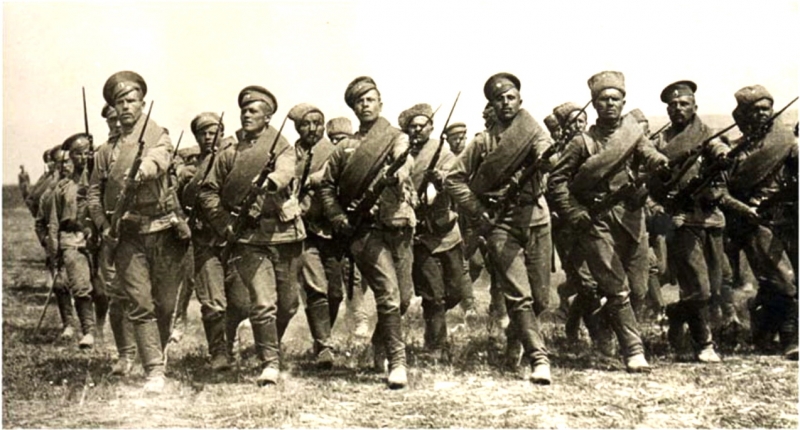
The performance characteristics of Mosin rifle Trehlineyka
– Adopted: 1891
– Constructor: Sergei Ivanovich Mosin
– designed: 1891 year
– Manufacturer: Tula Arms Plant
– Total production: about 37 000 000 units
Weight Mosin rifle
– 4,5 kg
Dimensions Mosin rifle
– with shtыkom / 1738mm without bayonet / 1306 mm (Infantry), 1500 mm / 1232 mm (Dragoon and arr. 1891/30), — / 1020 (carbine)
– barrel length, mm: 800 (Infantry), 729 (Dragoon and arr. 1891/30), 510 (carbine), 600 (Czech)
Mosin rifle cartridge
– 7,62× 54 mm R
Caliber rifle Mosin
– 7,62 (3 lines)
Rate Mosin rifle
– to 55 rounds / min
Mosin rifle bullet speed
– 865-870 m / s
Effective range
– 200 m
Work principles: rolling shutter
type boepitaniya: integrally cast shop in five rounds, equip collars
Aim: outdoor or optical
Photos Mosin rifle
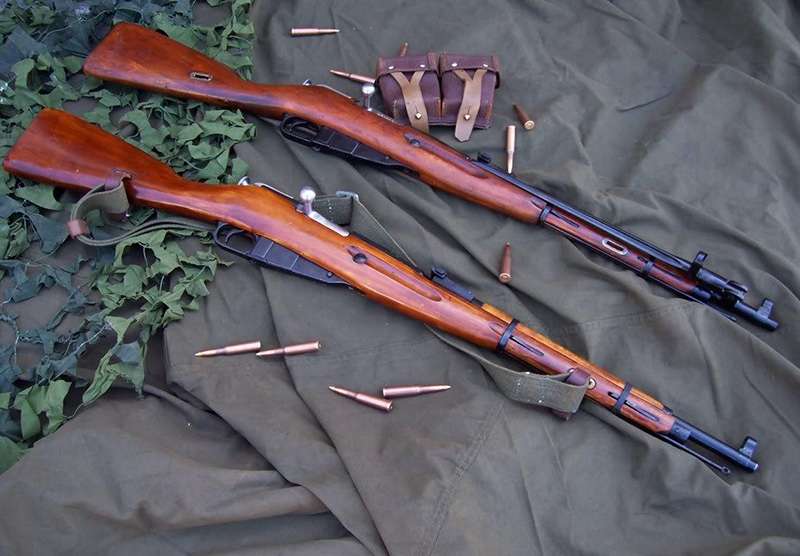
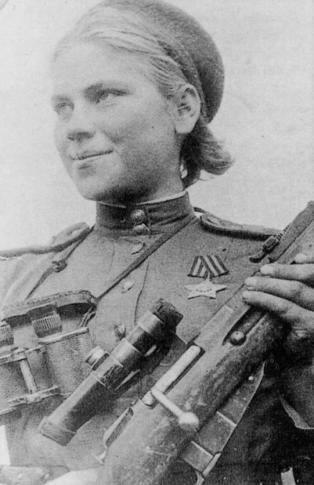
Sniper Roza Shanina with vitovkoy Mosin








